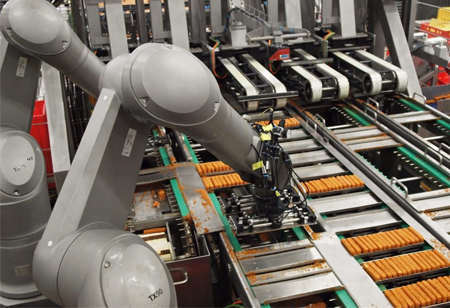THANK YOU FOR SUBSCRIBING
Be first to read the latest tech news, Industry Leader's Insights, and CIO interviews of medium and large enterprises exclusively from Food and Beverage Tech Review
Automation: The Silver Lining in COVID for Food Processing Sector
Storage solutions on the floor can be enhanced without human intervention with the extension of computerized warehouse systems.

By
Food and Beverages Tech Review | Friday, December 04, 2020
Stay ahead of the industry with exclusive feature stories on the top companies, expert insights and the latest news delivered straight to your inbox. Subscribe today.
Storage solutions on the floor can be enhanced without human intervention with the extension of computerized warehouse systems. Manufacturers and processors are finding these systems crucial for tracking a product’s status and refining turnaround times.
FREMONT, CA: Unarguably every industry has been impacted in some way by the coronavirus pandemic. Food manufacturing and processing are no different. COVID-19 has sparked a wave of reform within the sector and an opportunity to advance food processing and manufacturing to new heights. Explicitly, these challenges have nudged businesses to modernize their processes, particularly in terms of automation.
Despite the new conditions, food manufacturers are under intense pressure to continue operations. As a vital industry, food manufacturing has become more observant and experimental, with many firms finally embracing automation or developing new products and processes.
Many companies are seeing the value of automation and robotics to address worker volume and accountability concerns. This instance is true for everyone, from farmers to manufacturers. Observing the farming perspective, camera-based sorting systems, automated washing, peeling, and processing have permitted businesses to continue offering quality products. From automatic tray filling to tray denesters and product distribution systems, robots present vital functions.
See Also: Top Food and Beverages Consulting Companies
Storage solutions on the floor can be enhanced without human intervention with the extension of computerized warehouse systems. Manufacturers and processors are finding these systems crucial for tracking a product’s status and refining turnaround times. The food automation market, already expected to grow at approximately 7 percent, can see a growth rate closer to 9 percent with the growing adoption by the industry.
Other players in the sector have found themselves transforming their supply chains entirely. With employment dropping by more than 40 percent, the business has had to update longstanding supply chains. The pandemic has forced many restaurants to close, resulting in a sharp rise in demand from grocery stores and suppliers. For many, effectively navigating this sudden turn has become key to their innovation efforts.
Yet others are shifting production to make products they would not otherwise, pivoting from one food product to another. Like confectionary manufacturers and suppliers, some enterprises have had comprehensive paradigm shifts, turning to make Personal Protective Equipment (PPE). Both of these kinds of alterations are the result of the enhancement and updating of traditional processes.
I agree We use cookies on this website to enhance your user experience. By clicking any link on this page you are giving your consent for us to set cookies. More info








